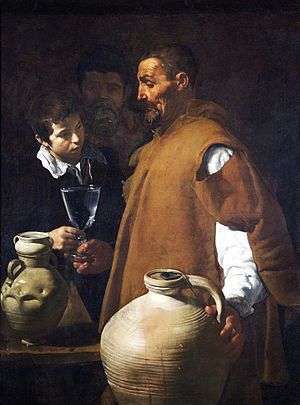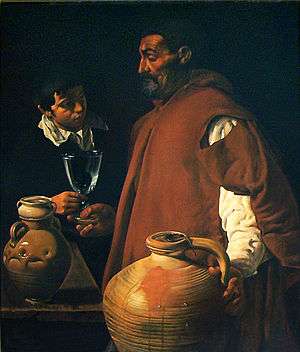The Waterseller of Seville (Velázquez)
 | |
| Artist | Diego Velázquez |
|---|---|
| Year | 1618–1622 |
| Medium | Oil on canvas |
| Dimensions | 105 cm × 80 cm (41 in × 31 in) |
| Location | Apsley House, London |
 | |
| Artist | Diego Velázquez |
|---|---|
| Year | 1618 |
| Medium | Oil on canvas |
| Dimensions | 104 cm × 75 cm (41 in × 30 in) |
| Location | Uffizi, Florence |
 | |
| Artist | Diego Velázquez |
|---|---|
| Year | 1620? |
| Medium | Oil on canvas |
The Waterseller of Seville is the title of three paintings by Spanish artist Diego Velázquez, dating from 1618–1622.
History
The painting exists in three versions. The version in the Apsley House, London, United Kingdom, was originally housed in the Royal Spanish Collection but stolen by Joseph Bonaparte at the time of the Napoleonic wars. The Duke of Wellington later won it back – along with 82 other paintings – at the Battle of Vitoria. The King of Spain allowed him to keep them in return for beating the French. Wellington brought the painting back to England where it remains to this day, in Apsley House, his former home.
The version in the Uffizi Gallery of Florence, painted two to four years earlier, has a rather more burlesque feel, with the seller wearing an ornate red hat. This may have been more in line with Velázquez's contemporaries' expectations due to the comical and devious image of the waterseller given in picaresque novels of the time.
The third version, takes yet another angle on the waterseller. In this he appears almost despairing in his expression, perhaps to the extent of appearing farcical. The brilliant colours used are the most extreme of the three (with the pots taking on an altogether more shiny appearance). However, as in the Uffizi version, the characters lack the depth of personality present in the Wellington version.
Description
The subject of the painting is the waterseller, a common trade for the lower classes in Velázquez's Seville. The jars and victuals recall the bodegón paintings. The seller has two customers: a young boy, possibly painted from the same model as used for the boys in The Lunch and Old Woman Cooking Eggs, and a young man in the background shadows, (time has caused him to fade somewhat – he is clearer in the Uffizi version).
In the foreground sit the seller's gigantic pots of water, glistening with splashes of water. So large and rounded, they almost protrude out of the painting into the observer's space. The seller hands a freshly poured glass of water to the boy. In it sits a fig, a perfumer intended to make the water taste fresher (something still done in Seville today).
The still, calm scene – a typical quality of his genre scenes and, indeed, much of Velázquez's work – is remarkable for the depiction of the seller. His pensive face, battered by its direct exposure to sunlight and deeply scarred with the wrinkles of age, speaks of long years of experience. His short shaved hair and old plain clothes give him the appearance of a monk, saint, or eccentric philosopher. He gazes into nothing, indicating deep thought, almost unaware of those around him.
Velázquez's respect for the poor is evidence in the idea that the simple, elemental nature of poverty is profound and effective in depicting higher subjects and morals such as biblical stories (such as the Christ in the House of Martha and Mary).
Another proponent of this idea was Caravaggio, who significantly influenced this painting. Caravaggio went against the idealistic trends of Mannerism and the Renaissance, painting saints and divine beings as fallible cripples and prostitutes. Whilst not as aggressively provocative as Caravaggio, Velázquez does not by any means idealize his subject. Rather, he aims to represent it in a way that is precisely faithful to life. He captures the imperfections of the seller's pots, the dampness on their sides, the glistening of the light on the small drops of water and the glass, and the realistic expressions of the characters.
In the context of Velázquez's development as an artist, The Waterseller exhibits the beginnings of the technique found in the artist's mature creations. His insight into the person of the seller is symptomatic of his insight into the subjects of his great portraits, and his precise rendition of the small details of reality demonstrate his understanding of human perception.
Sources
- Romano, Eileen (2006). Art Classics: Velázquez. ISBN 0-8478-2812-3.
- Wolf, Norbert (2006). Diego Velázquez. ISBN 3-8228-6324-6.
- "Portrait of the week: The Water-Seller of Seville, Velazquez (c1620)". The Guardian., Retrieved on 2007-01-24.
External links
- Velázquez , exhibition catalog from The Metropolitan Museum of Art (fully available online as PDF), which contains material on The Waterseller of Seville (see index)
